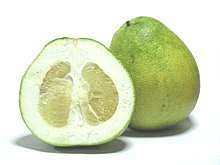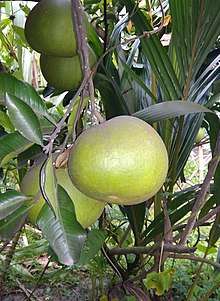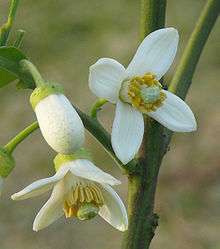Pomelo
| Pomelo | |
|---|---|
 | |
 | |
| Scientific classification | |
| Kingdom: | Plantae |
| Clade: | Tracheophytes |
| Clade: | Angiosperms |
| Clade: | Eudicots |
| Clade: | Rosids |
| Order: | Sapindales |
| Family: | Rutaceae |
| Genus: | Citrus |
| Species: | C. maxima |
| Binomial name | |
| Citrus maxima | |
_001.jpg)


 Flesh of a pomelo | |
| Nutritional value per 100 g (3.5 oz) | |
|---|---|
| Energy | 159 kJ (38 kcal) |
9.62 g | |
| Dietary fiber | 1 g |
0.04 g | |
0.76 g | |
| Vitamins | Quantity %DV† |
| Thiamine (B1) | 3% 0.034 mg |
| Riboflavin (B2) | 2% 0.027 mg |
| Niacin (B3) | 1% 0.22 mg |
| Vitamin B6 | 3% 0.036 mg |
| Vitamin C | 73% 61 mg |
| Minerals | Quantity %DV† |
| Iron | 1% 0.11 mg |
| Magnesium | 2% 6 mg |
| Manganese | 1% 0.017 mg |
| Phosphorus | 2% 17 mg |
| Potassium | 5% 216 mg |
| Sodium | 0% 1 mg |
| Zinc | 1% 0.08 mg |
| Other constituents | Quantity |
| Water | 89 g |
| |
| †Percentages are roughly approximated using US recommendations for adults. Source: USDA Nutrient Database | |
The pomelo, pummelo, or in scientific terms Citrus maxima or Citrus grandis, is the largest citrus fruit from the family Rutaceae and the principal ancestor of the grapefruit.[1] It is a natural, i.e., non-hybrid, citrus fruit, native to Southeast Asia.[1] Similar in taste to a large grapefruit, the pomelo is commonly consumed and used for festive occasions throughout Southeast Asia.
Etymology
The etymology of the word "pomelo" derived from Dutch pompelmoes, which is rendered pampelmuse in German, and pamplemousse in French.[1] Its botanical name, Citrus maxima, means "biggest citrus". In English, the word "pomelo" (also spelled pomello, pummelo, pommelo, pumelo) has become the more common name, although "pomelo" has historically been used for grapefruit. (The 1973 printing of the American Heritage Dictionary, for example, gives grapefruit as the only meaning of "pomelo.")
After a captain Shaddock of an East India Company ship introduced it to Barbados, the fruit was called "shaddock" in English.[2][3] From there the name spread to Jamaica in 1696.[4] It remains a common name for the fruit among English authors.[5] The fruit is also known as jabong in Hawaii and jambola in varieties of English spoken in South Asia.[1]
Description and uses
The pomelo tree may be 16–50 feet (4.9–15.2 m) tall, possibly with a crooked trunk 4–12 inches (10–30 cm) thick, and low-hanging, irregular branches.[1] Leaf petioles are distinctly winged, with alternate, ovate or elliptic shapes 2–8 inches (51–203 mm) long, with a leathery, dull green upper finish, and hairy lower leaf.[1] The flowers – single or in clusters – are fragrant and yellow-white in color.[1]
The pomelo is a large citrus fruit, 15–25 centimetres (6–10 in) in diameter,[6] usually weighing 1–2 kilograms (2–4 lb). It has a thicker rind than a grapefruit.[1] Containing 11–18 segments, the flesh tastes like a mild grapefruit (believed to be a hybrid of Citrus maxima and the orange).[1][7] The flesh has little of the common grapefruit bitterness. The enveloping membranous material around the segments is bitter, considered inedible, and usually discarded.[1] There are two varieties: a sweet kind with white flesh, and a sour kind with pinkish flesh, the latter more likely to be used as a ceremony, rather than eaten.[1] The fruit generally contains few, relatively large seeds, but some varieties have numerous seeds.[1]
The juice is regarded as delicious, and the rind is used to make preserves or may be candied.[1] In Brazil, the thick skin may be used for making a sweet conserve, while the spongy pith of the rind is discarded. In Sri Lanka, it is often eaten as a dessert, either raw or sprinkled with sugar. Some fatty Asian dishes use sliced pre-soaked pith to absorb the sauce and fat for eating. In large parts of Southeast Asia where pomelo is native, it is a common dessert, often eaten raw and sprinkled with, or dipped in, a salt mixture. It is eaten in salads.[1] In the Philippines, the juice is mixed with pineapple and made into a pink drink.[8]
The fruit may have been introduced to China around 100 BC.[1]
Propagation and genetic diversity
Citrus maxima is usually grafted onto other citrus rootstocks, but may be grown from seed.[1] Though the seeds of the pomelo are monoembryonic, producing seedlings identical to their parents, and therefore pomelo is typically grown from seed.[1] Seeds can be stored for 80 days at 41 °F (5 °C) and with moderate relative humidity.[1] High-quality varieties are propagated by air-layering or by budding onto favored rootstocks.[1]
A wide variability in the physical and chemical characteristics of pomelo occurs across southern Asia.[1]
Varieties
Non-hybrid pomelos
Possible non-hybrid pomelos
Hybrids
The pomelo is one of the original citrus species from which the rest of cultivated citrus have been hybridized, (others being citron, mandarin, and to a lesser extent, papedas and kumquat). In particular, the common orange and the grapefruit are presumed to be naturally occurring hybrids between the pomelo and the mandarin, with the pomelo providing the larger size and greater firmness.
The pomelo is employed today in artificial breeding programs:
- The common sweet orange (Citrus × sinensis) is a pomelo × mandarin hybrid
- The bitter orange (Citrus × aurantium) is another pomelo × mandarin hybrid
- The tangelo is any hybrid between Citrus maxima and a tangerine, it generally has a thicker skin than a tangerine and is less sweet
- 'K–Early' ('Sunrise Tangelo')[9]
- Grapefruit is a pomelo backcross: pomelo × sweet orange (see above) and the grapefruit is in turn a parent to many hybrids:
- 'Minneola': Bowen grapefruit × Dancy tangerine[9]
- 'Orlando' (formerly 'Take'): Bowen grapefruit × Dancy tangerine (pollen parent)[9]
- 'Nova': Clementine × Orlando tangelo cross[9]
- 'Seminole': Bowen grapefruit × Dancy tangerine[9]
- 'Thornton': tangerine × grapefruit, unspecified[9]
- 'Ugli': mandarine × grapefruit, probable (wild seedling)[9]
- The Oroblanco and Melogold grapefruits are hybrids between Citrus maxima and the grapefruit
- Mandelos: pomelo × mandarine (Citrus maxima)
- Hyuganatsu is a pomelo hybrid
Nutrition
Raw pomelo flesh is 89% water, 10% carbohydrates, 1% protein, and contains negligible fat (table). A 100 gram reference amount provides 38 calories, and is rich in vitamin C (73% of the Daily Value), with no other micronutrients in significant content (table).
Potential for drug interaction
As a species of citrus, pomelo may cause adverse effects, similar to those caused by grapefruit, through the inhibition of cytochrome P450-mediated metabolism of prescription drugs such as anti-hypertensives and anticoagulants.[10]
Gallery
_Merr.)%3B_flowe_Wellcome_V0042686.jpg) Flowering and fruiting branch with numbered fruit segment and flower section, chromolithograph by P. Depannemaeker, c. 1885, after B. Hoola van Nooten
Flowering and fruiting branch with numbered fruit segment and flower section, chromolithograph by P. Depannemaeker, c. 1885, after B. Hoola van Nooten This white hybrid Pomelo is cushioned with a thick mesocarp layer
This white hybrid Pomelo is cushioned with a thick mesocarp layer Pomelos
Pomelos Pomelo after being cut
Pomelo after being cut Pink pomelo juice vesicles
Pink pomelo juice vesicles_004.jpg) Pomelo blossom
Pomelo blossom Pomelo on tree, has fruit and blossoms at the same time
Pomelo on tree, has fruit and blossoms at the same time- Fujian's Pinghe County is famous in China for its pomelos
 Pomelo orchard
Pomelo orchard Pink pomelo
Pink pomelo Pomelo seedling
Pomelo seedling_005.jpg) Closeup of pomelo petiole
Closeup of pomelo petiole- Ipoh pomelos on sale at Chinatown, Singapore
- Tam som-o nam pu: spicy Thai pomelo salad with crab extract
References
- Julia F Morton (1987). "Pummelo: Citrus maxima; p. 147-151. In: Fruits of warm climates". NewCROP, New Crop Resource Online Program, Center for New Crops and Plant Products, Purdue University. Retrieved 31 January 2020.
- "Pomelo (Pummelo) Citrus maxima". Citruspages.free.fr. 2009-11-14. Retrieved 2020-07-06.
- "fruitInfo-trdLevel2021.html". Itfnet.org. 2008-06-12. Retrieved 2020-07-06.
- American Heritage Dictionary, 1973.
- "Shaddock". Britannica Online. Encyclopædia Britannica, Inc. Retrieved 1 January 2017.
- "Pomelo: Growing the granddaddy of grapefruit", SFGate.com, December 25, 2004
- Julia F Morton (1987). "Grapefruit: Citrus paradisi; p. 152–158. In: Fruits of warm climates". NewCROP, New Crop Resource Online Program, Center for New Crops and Plant Products, Purdue University. Retrieved 31 January 2020.
- Hargreaves, Dorothy; Hargreaves, Bob (1970). Tropical Trees of the Pacific. Kailua, Hawaii: Hargreaves. p. 51.
- Morton, Julia F. (1987). "Tangelo". Fruits of warm climates. Miami, FL.: Julia F. Morton. pp. 158–160. ISBN 0-9610184-1-0.
- Bailey, D. G.; Dresser, G.; Arnold, J. M. O. (2012-11-26). "Grapefruit-medication interactions: Forbidden fruit or avoidable consequences?". Canadian Medical Association Journal. 185 (4): 309–316. doi:10.1503/cmaj.120951. ISSN 0820-3946. PMC 3589309. PMID 23184849.